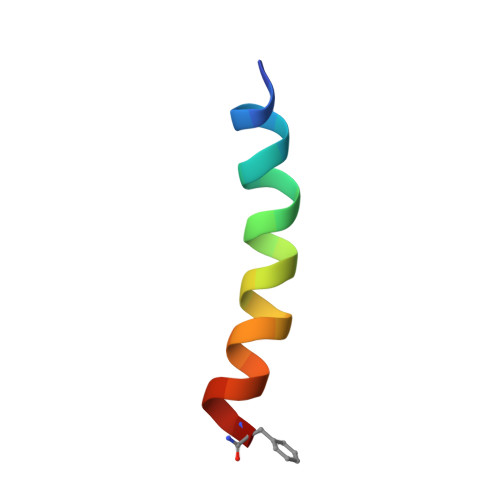Structural Studies of a Lipid-Binding Peptide from Tunicate Hemocytes with Anti-Biofilm Activity.
Silva, O.N., Alves, E.S., de la Fuente-Nunez, C., Ribeiro, S.M., Mandal, S.M., Gaspar, D., Veiga, A.S., Castanho, M.A., Andrade, C.A., Nascimento, J.M., Fensterseifer, I.C., Porto, W.F., Correa, J.R., Hancock, R.E., Korpole, S., Oliveira, A.L., Liao, L.M., Franco, O.L.(2016) Sci Rep 6: 27128
- PubMed: 27292548
- DOI: https://doi.org/10.1038/srep27128
- Primary Citation of Related Structures:
6C41 - PubMed Abstract:
Clavanins is a class of peptides (23aa) histidine-rich, free of post-translational modifications. Clavanins have been studied largely for their ability to disrupt bacterial membranes. In the present study, the interaction of clavanin A with membranes was assessed by dynamic light scattering, zeta potential and permeabilization assays. We observed through those assays that clavanin A lysis bacterial cells at concentrations corresponding to its MIC. Further, the structure and function of clavanin A was investigated. To better understand how clavanin interacted with bacteria, its NMR structure was elucidated. The solution state NMR structure of clavanin A in the presence of TFE-d3 indicated an α-helical conformation. Secondary structures, based on circular dichroism measurements in anionic sodium dodecyl sulfate (SDS) and TFE (2,2,2-trifluorethanol), in silico lipid-peptide docking and molecular simulations with lipids DPPC and DOPC revealed that clavanin A can adopt a variety of folds, possibly influencing its different functions. Microcalorimetry assays revealed that clavanin A was capable of discriminating between different lipids. Finally, clavanin A was found to eradicate bacterial biofilms representing a previously unrecognized function.
Organizational Affiliation:
Departamento Biologia, Instituto de Ciências Biológicas, Programa de pós-graduação em Genética e Biotecnologia, Universidade Federal de Juiz de Fora, Juiz de Fora-MG, 36036-900, Brazil.














